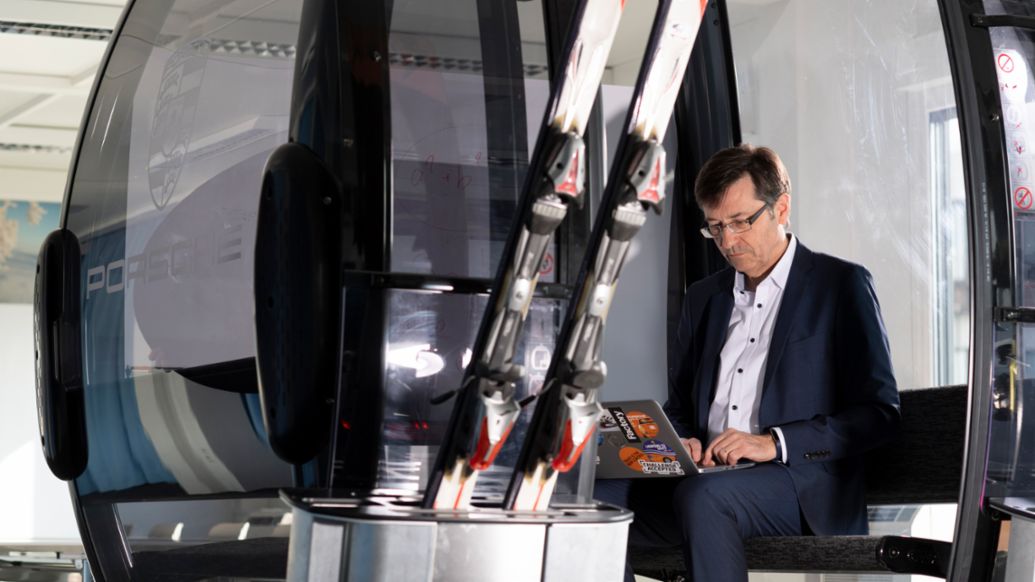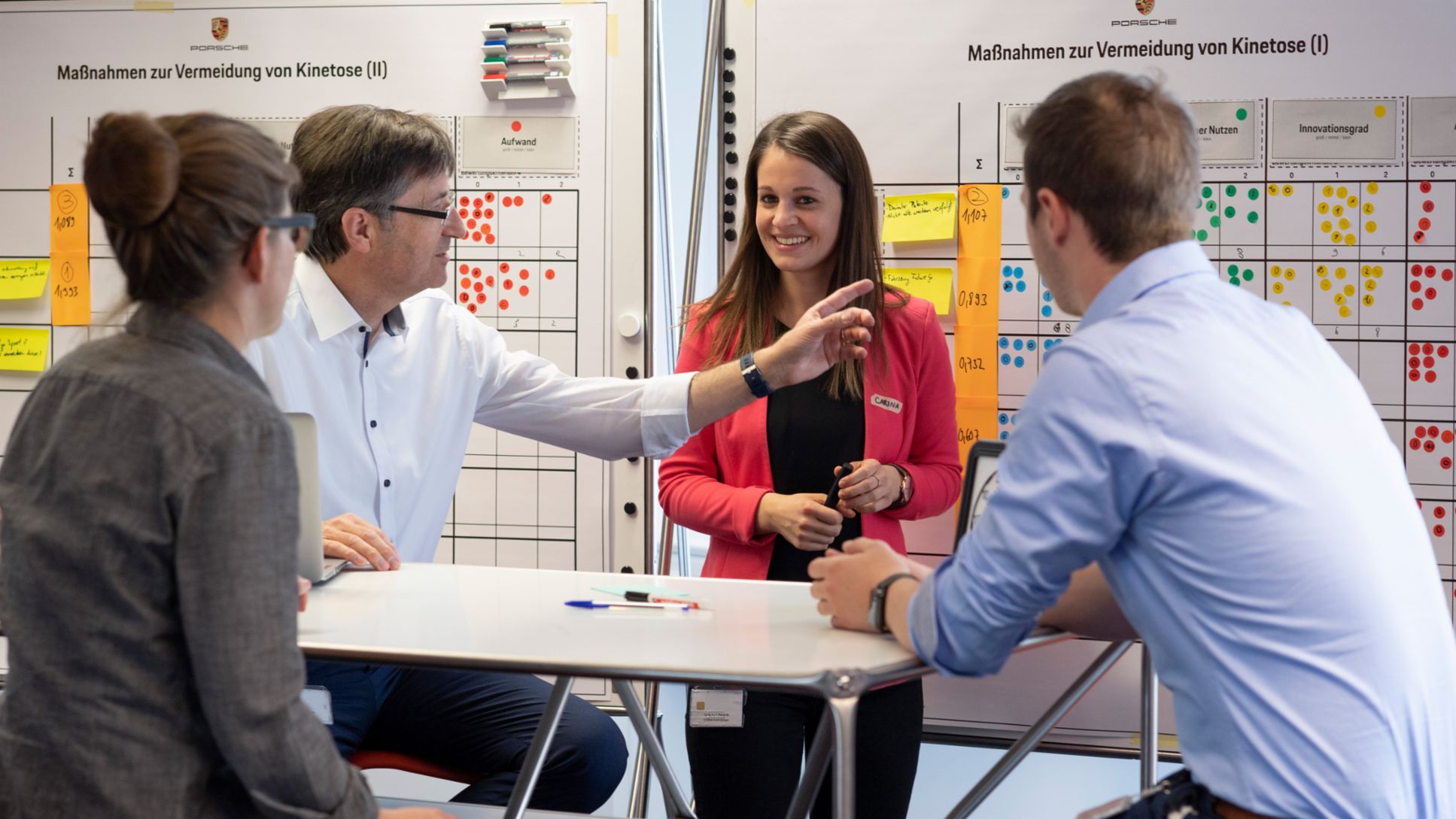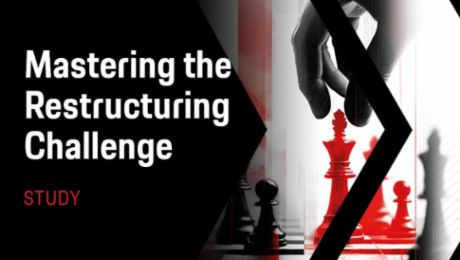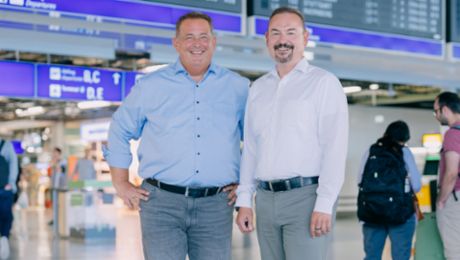A Porsche 911 on a wet road. Spray shoots up around the tires. Acoustic sensors in the front wheelhouses detect the danger of hydroplaning. A message appears on the display to warn the driver, who activates Porsche Wet Mode to maintain the greatest possible degree of stability. Various driver assistance systems and settings automatically adapt to address the dangerous situation. This technology became available in spring 2019 in the eighth-generation Porsche icon. Innovations like this always have a long lead-up time. Years before Wet Mode entered series production, the idea behind it was put through feasibility tests by the chassis preliminary development department. Anyone who wants to know what a Porsche will be able to do in 2030 is advised to seek out Porsche’s innovation managers in Weissach near Stuttgart. Here is where Uwe Reuter and his team of engineers and data scientists work on innovations that could take a decade before entering mass production.
Reuter is convinced that innovative working methods enhance the innovative capacities of his approximately 30-member team. Design thinking, scrums, ideation workshops, communities, and hackathons are of course part of its repertoire but not enough to achieve an innovative working atmosphere. This was clear to Reuter’s team upon moving into a new building on the grounds of the Porsche Development Center in 2017. “We quickly realized that we could not work there the way we wanted and had to in order to fulfill our role as an engine for innovation,” he says. The classic layout of the offices and their furnishings seemed too rigid. So the team collaborated with Porsche Consulting and in just two weeks implemented immediate measures for a more flexible and productive workplace and developed a concept for restructuring the space.
The perfect work day for developers
“We started our two-week sprint with the question of what the perfect workday for developers should look like,” says Porsche Consulting’s Wolfgang Freibichler. An analysis of the starting situation revealed what changes were needed to reach this ideal state. How much time do team members spend at work stations, and how much in meetings? How many people take part in these meetings? How easy is it to concentrate on work in the office? After one day the developers had compiled all the facts. And they were astonishing. “Many desks were empty for hours because we often sit together in small teams,” says Reuter. “Half the individual shelf space went unused. It’s extremely important for innovation managers to work with their colleagues from other departments. Yet a constant stream of visitors is distracting for those who need to concentrate and work quietly on their own.”

Within a few days the employees had developed customized solutions for the weak points. “In searching for solutions we concentrated on four core areas of New Work,” says Reuter. Concentration, collaboration, communication, and contemplation reflect innovation managers’ four most important needs. All four serve their purpose. The ideal combination thereof was sought—and found. The number of individual work stations was reduced to acquire more room for flexible open spaces. Instead of cavernous conference rooms that are booked by different teams on a sequential basis, the department needed smaller consultation rooms in which ideas could remain written on the walls for a while. Armchairs for reading, focus rooms, and isolated work stations offer places to retreat and work without distractions.
New working atmosphere in two weeks
“We were able to put a lot of things into practice right away and without rebuilding anything,” says Reuter and lists a few examples. “Big hourglasses at desks promote concentration by signaling the person does not want to be disturbed for half an hour. We put writeable and magnetic surfaces on the walls to facilitate agile and interactive ways of working together. And new digital communication tools are making it easier to share the results of our projects.” One popular new option consists of “walking meetings” on the grounds of the development center. Team members can use their digital calendars to select a walking route instead of a conference space, because physical exercise also promotes mental performance.
These solutions are based on the “nudge management” approach developed by Porsche Consulting. Its effectiveness is derived from addressing human instincts in targeted ways. Small changes in framework conditions, known as nudges, make it easy for people to behave more efficiently. “Nudge management is particularly helpful if you want to achieve lasting behavioral changes,” says Freibichler. After only two weeks, the Porsche developers noted a marked improvement in their work climate. It could also be measured, in this case with productivity increasing by more than 10 percent. At the same time, the team of specialists is also more satisfied with its working conditions, because its members now experience more flow and less stress—a significant initial success for the pilot project, which also serves as a model for other departments at Porsche.
In the meantime the chassis preliminary development department has returned to concentrating fully on the innovations of the future. Cars should not only be able to detect current dangers such as hydroplaning but also think in advance, communicate, and even act autonomously if so desired. Cameras, radar, and laser sensors will be linked in the cloud. Data on traffic and weather conditions will be immediately analyzed and shared with connected vehicles, which will warn each other about problems, such as black ice and congestion, and thereby improve traffic flow and lower accident levels. In other words, there will be no shortage of innovations on which Uwe Reuter and his team are already working in their cutting-edge environment.
Info
Photos: Porsche Consulting GmbH




